Frictional Pressure Drop and Cost Savings for Graphene Nanoplatelets Nanofluids in Turbulent Flow Environments
Abstract
:1. Introduction
1.1. Research Background
1.2. Research Motivation and Literature Review
1.3. Research Objectives
2. Methodology
2.1. Preparation of Nanofluids
2.2. Characterization Techniques of Nanofluids
2.3. Numerical Parameters and Procedures
2.3.1. Physical Model and Assumptions
- i.
- CF-GNPs/DW can be considered as a single-phase fluid.
- ii.
- Base fluid (water) and CF-GNPs nanoparticles are within thermal equilibrium at zero relative velocity.
- iii.
- The nanofluids are Newtonian fluids.
- iv.
- Thermophysical properties of nanofluid samples change with increasing weight concentrations.
- v.
- Its temperature dependence is negligible due to the minimal temperature variations throughout the study.
2.3.2. Governing Equations
2.3.3. Grid Optimization
2.3.4. Simulations Validation and Verification
2.4. Cost Analysis
3. Applications Results and Analysis
3.1. Nanofluids Characterization and Thermophysical Characteristics
3.2. Frictional Pressure Drop and Nanofluid Flow
3.3. Pumping Power and Cost Savings
4. Conclusions
Supplementary Materials
Author Contributions
Funding
Data Availability Statement
Conflicts of Interest
Nomenclature
| Al2O3 | Aluminum oxide |
| AlCl3 | Aluminum chloride |
| CFD | Computational fluid dynamics |
| CF-GNPs | Covalent functionalized Graphene nanoplatelets |
| D | Pipe diameter |
| DLS | Dynamic light scattering |
| DMF | N, N-dimethylformamide |
| DW | Distilled water |
| EDX | Energy-dispersive X-ray spectroscopy |
| EG | Ethylene glycol |
| EO | Engine oil |
| FE-SEM | Scanning electron microscopy |
| HCl | Hydrochloric acid |
| Keff | Effective molecular conductivity |
| PDI | Polydispersity index |
| PEG | Pentaethylene glycol |
| PGGNP | Propylene glycol-treated graphene Nanoplatelet |
| Re | Reynolds number |
| SDBS | Sodium dodecylbenzene sulfonate |
| SiO2 | Silicon dioxide |
| THF | Tetrahydrofuran |
| Tin | Inlet temperature |
| U | Freestream velocity |
| Ueff | Effective viscosity of nanofluid |
| UV-visible | Ultraviolet-Visible—Spectrophotometer |
| Vin | Inlet velocity |
| Vwall | Wall velocity |
| Hydraulic pumping power (W) | |
| Y+ | Dimensionless wall distance |
| ΔP | Pressure drop (Pa/m) |
| Δy | Wall spacing |
Greek Symbols
| ε | Turbulent dissipation |
| ρ | Density |
| τw | Wall shear stress |
| µ | Viscosity |
| Cf | Skin friction factor |
| k | Kinetic energy |
| μt | Coefficient of viscosity in turbulent Regime |
| Uτ | Friction velocity |
| kt | Turbulent thermal conductivity |
| f | Friction factor |
References
- Zubir, M.N.M.; Badarudin, A.; Kazi, S.N.; Misran, M.; Amiri, A.; Sadri, R.; Khalid, S. Experimental investigation on the use of highly charged nanoparticles to improve the stability of weakly charged colloidal system. J. Colloid Interface Sci. 2015, 454, 245–255. [Google Scholar] [CrossRef] [PubMed]
- Pordanjani, A.H.; Aghakhani, S.; Afrand, M.; Sharifpur, M.; Meyer, J.P.; Xu, H.; Ali, H.M.; Karimi, N.; Cheraghian, G. Nanofluids: Physical phenomena, applications in thermal systems and the environment effects-a critical review. J. Clean. Prod. 2021, 320, 128573. [Google Scholar] [CrossRef]
- Maghrabie, H.M. Heat transfer intensification of jet impingement using exciting jets-A comprehensive review. Renew. Sustain. Energy Rev. 2021, 139, 110684. [Google Scholar] [CrossRef]
- Soltanimehr, M.; Afrand, M. Thermal conductivity enhancement of COOH-functionalized MWCNTs/ethylene glycol–water nanofluid for application in heating and cooling systems. Appl. Therm. Eng. 2016, 105, 716–723. [Google Scholar] [CrossRef]
- Rasheed, A.K.; Khalid, M.; Rashmi, W.; Gupta, T.; Chan, A. Graphene based nanofluids and nanolubricants–Review of recent developments. Renew. Sustain. Energy Rev. 2016, 63, 346–362. [Google Scholar] [CrossRef]
- Sadri, R.; Mallah, A.R.; Hosseini, M.; Ahmadi, G.; Kazi, S.N.; Dabbagh, A.; Yeong, C.H.; Ahmad, R.; Yaakup, N.A. CFD modeling of turbulent convection heat transfer of nanofluids containing green functionalized graphene nanoplatelets flowing in a horizontal tube: Comparison with experimental data. J. Mol. Liq. 2018, 269, 152–159. [Google Scholar] [CrossRef]
- Trisaksri, V.; Wongwises, S. Critical review of heat transfer characteristics of nanofluids. Renew. Sustain. Energy Rev. 2007, 11, 512–523. [Google Scholar] [CrossRef]
- Daungthongsuk, W.; Wongwises, S. A critical review of convective heat transfer of nanofluids. Renew. Sustain. Energy Rev. 2007, 11, 797–817. [Google Scholar] [CrossRef]
- Huang, J.; Liu, H.; Chen, S.; Ding, C. Graphene aerogel prepared through double hydrothermal reduction as high-performance oil adsorbent. Mater. Sci. Eng. B 2017, 226, 141–150. [Google Scholar] [CrossRef]
- Shazali, S.S.; Rozali, S.; Amiri, A.; Zubir, M.N.M.; Sabri, M.F.M.; Zabri, M.Z. Evaluation on stability and thermophysical performances of covalently functionalized graphene nanoplatelets with xylitol and citric acid. Mater. Chem. Phys. 2018, 212, 363–371. [Google Scholar] [CrossRef]
- Rana, S.; Jonnalagadda, S.B. Synthesis and characterization of amine functionalized graphene oxide and scope as catalyst for Knoevenagel condensation reaction. Catal. Commun. 2017, 92, 31–34. [Google Scholar] [CrossRef]
- Chatterjee, S.; Wang, J.W.; Kuo, W.S.; Tai, N.H.; Salzmann, C.; Li, W.L.; Hollertz, R.; Nüesch, F.A.; Chu, B.T.T. Mechanical reinforcement and thermal conductivity in expanded graphene nanoplatelets reinforced epoxy composites. Chem. Phys. Lett. 2012, 531, 6–10. [Google Scholar] [CrossRef]
- Bose, S.; Drzal, L.T. Functionalization of Graphene Nanoplatelets Using Sugar Azide for Graphene/Epoxy Nanocomposites; Michigan State University East Lansing Composite Materials Structures Center: Michigan, MI, USA, 2014. [Google Scholar]
- Mahdi, F.; Mahmood, O. Effect of yttrium oxide on mechanical and physical properties of Fe–10%cu composite. Tikrit J. Eng. Sci. 2020, 27, 67–72. [Google Scholar] [CrossRef]
- Sarsam, W.S.; Amiri, A.; Zubir, M.N.M.; Yarmand, H.; Kazi, S.N.; Badarudin, A. Stability and thermophysical properties of water-based nanofluids containing triethanolamine-treated graphene nanoplatelets with different specific surface areas. Colloids Surf. A Physicochem. Eng. Asp. 2016, 500, 17–31. [Google Scholar] [CrossRef]
- Taha, A.A.; Mousa, A.; Al-ott, M.; Faroun, M.; Assali, M.; Gomez, P.R.; Thiab, S. Non-Covalent Functionalization of Graphene Sheets with Surfactants and Their Antibacterial Activity; Al-Quds University: Jerusalem, Palestine, 2016. [Google Scholar]
- Jia, J.; Sun, X.; Lin, X.; Shen, X.; Mai, Y.-W.; Kim, J.-K. Exceptional electrical conductivity and fracture resistance of 3D interconnected graphene foam/epoxy composites. ACS Nano 2014, 8, 5774–5783. [Google Scholar] [CrossRef]
- Huang, X.; Qi, X.; Boey, F.; Zhang, H. Graphene-based composites. Chem. Soc. Rev. 2012, 41, 666–686. [Google Scholar] [CrossRef]
- Sadeghinezhad, E.; Togun, H.; Mehrali, M.; Sadeghi Nejad, P.; Tahan Latibari, S.; Abdulrazzaq, T.; Kazi, S.N.; Metselaar, H.S.C. An experimental and numerical investigation of heat transfer enhancement for graphene nanoplatelets nanofluids in turbulent flow conditions. Int. J. Heat Mass Transf. 2015, 81, 41–51. [Google Scholar] [CrossRef] [Green Version]
- Solangi, K.H.; Amiri, A.; Luhur, M.R.; Ghavimi, S.A.A.; Zubir, M.N.M.; Kazi, S.N.; Badarudin, A. Experimental investigation of the propylene glycol-treated graphene nanoplatelets for the enhancement of closed conduit turbulent convective heat transfer. Int. Commun. Heat Mass Transf. 2016, 73, 43–53. [Google Scholar] [CrossRef]
- Yarmand, H.; Gharehkhani, S.; Shirazi, S.F.S.; Amiri, A.; Alehashem, M.S.; Dahari, M.; Kazi, S.N. Experimental investigation of thermo-physical properties, convective heat transfer and pressure drop of functionalized graphene nanoplatelets aqueous nanofluid in a square heated pipe. Energy Convers. Manag. 2016, 114, 38–49. [Google Scholar] [CrossRef]
- Sadri, R.; Hosseini, M.; Kazi, S.N.; Bagheri, S.; Abdelrazek, A.H.; Ahmadi, G.; Zubir, N.; Ahmad, R.; Abidin, N.I.Z. A facile, bio-based, novel approach for synthesis of covalently functionalized graphene nanoplatelet nano-coolants toward improved thermo-physical and heat transfer properties. J. Colloid Interface Sci. 2018, 509, 140–152. [Google Scholar] [CrossRef]
- Abdelrazek, A.H.; Kazi, S.N.; Alawi, O.A.; Yusoff, N.; Oon, C.S.; Ali, H.M. Heat transfer and pressure drop investigation through pipe with different shapes using different types of nanofluids. J. Therm. Anal. Calorim. 2020, 139, 1637–1653. [Google Scholar] [CrossRef]
- Abbas, E.F.; Mohammed, S.S. Study the effect of granules type of the porous medium on the heat transfer enhancement for double pipe heat exchanger. Tikrit J. Eng. Sci. 2019, 26, 43–49. [Google Scholar] [CrossRef]
- Alawi, O.A.; Sidik, N.A.C.; Kazi, S.N.; Najafi, G. Graphene nanoplatelets and few-layer graphene studies in thermo-physical properties and particle characterization. J. Therm. Anal. Calorim. 2019, 135, 1081–1093. [Google Scholar] [CrossRef]
- Hussein, O.A.; Habib, K.; Saidur, R.; Muhsan, A.S.; Shahabuddin, S.; Alawi, O.A. The influence of covalent and non-covalent functionalization of GNP based nanofluids on its thermophysical, rheological and suspension stability properties. RSC Adv. 2019, 9, 38576–38589. [Google Scholar] [CrossRef] [Green Version]
- Alawi, O.A.; Mallah, A.R.; Kazi, S.N.; Sidik, N.A.C.; Najafi, G. Thermophysical properties and stability of carbon nanostructures and metallic oxides nanofluids: Experimental approach. J. Therm. Anal. Calorim. 2018, 135, 1545–1562. [Google Scholar] [CrossRef]
- Abdelrazek, A.H.; Alawi, O.A.; Kazi, S.N.; Yusoff, N.; Chowdhury, Z.; Sarhan, A.A.D. A new approach to evaluate the impact of thermophysical properties of nanofluids on heat transfer and pressure drop. Int. Commun. Heat Mass Transf. 2018, 95, 161–170. [Google Scholar] [CrossRef]
- Aldlemy, M. Effect of conductivity in corrosion problem using boundary element method and genetic algorithm. Knowl. Based Eng. Sci. 2020, 1, 58–63. [Google Scholar] [CrossRef]
- Launder, B.E.; Spalding, D.B. The numerical computation of turbulent flows. Comput. Methods Appl. Mech. Eng. 1974, 3, 269–289. [Google Scholar] [CrossRef]
- Ameen, A.; Ibrahim, Z.; Othman, F.; Al-Ansari, N.; Yaseen, Z. Minimizing the principle stresses of powerhoused Rock-Fill dams using control turbine running units: Application of Finite Element Method. Water 2018, 10, 1138. [Google Scholar] [CrossRef] [Green Version]
- Blasius, H. Grenzschichten in Flussigkeiten mit kleiner Reibung. Z. Math. Phys. 1908, 56, 1–37. [Google Scholar]
- Pan, D.; Zhang, J.; Li, Z.; Wu, M. Hydrothermal route for cutting graphene sheets into blue-luminescent graphene quantum dots. Adv. Mater. 2010, 22, 734–738. [Google Scholar] [CrossRef]
- Amiri, A.; Kazi, S.N.; Shanbedi, M.; Mohd Zubir, M.N.; Yarmand, H.; Chew, B.T. Transformer oil based multi-walled carbon nanotube-hexylamine coolant with optimized electrical, thermal and rheological enhancements. RSC Adv. 2015, 5, 107222–107236. [Google Scholar] [CrossRef]
- Amrollahi, A.; Rashidi, A.M.; Emami Meibodi, M.; Kashefi, K. Conduction heat transfer characteristics and dispersion behaviour of carbon nanofluids as a function of different parameters. J. Exp. Nanosci. 2009, 4, 347–363. [Google Scholar] [CrossRef]
- Georgakilas, V.; Otyepka, M.; Bourlinos, A.B.; Chandra, V.; Kim, N.; Kemp, K.C.; Hobza, P.; Zboril, R.; Kim, K.S. Functionalization of graphene: Covalent and non-covalent approaches, derivatives and applications. Chem. Rev. 2012, 112, 6156–6214. [Google Scholar] [CrossRef] [PubMed]
- Baby, T.T.; Sundara, R. Synthesis and transport properties of metal oxide decorated graphene dispersed nanofluids. J. Phys. Chem. C 2011, 115, 8527–8533. [Google Scholar] [CrossRef]
- Yang, L.; Xu, J.; Du, K.; Zhang, X. Recent developments on viscosity and thermal conductivity of nanofluids. Powder Technol. 2017, 317, 348–369. [Google Scholar] [CrossRef]
- Mansour, R.B.; Galanis, N.; Nguyen, C.T. Effect of uncertainties in physical properties on forced convection heat transfer with nanofluids. Appl. Therm. Eng. 2007, 27, 240–249. [Google Scholar] [CrossRef]
- Naddaf, A.; Heris, S.Z.; Pouladi, B. An experimental study on heat transfer performance and pressure drop of nanofluids using graphene and multi-walled carbon nanotubes based on diesel oil. Powder Technol. 2019, 352, 369–380. [Google Scholar] [CrossRef]
- Keklikcioglu, O.; Dagdevir, T.; Ozceyhan, V. Heat transfer and pressure drop investigation of graphene nanoplatelet-water and titanium dioxide-water nanofluids in a horizontal tube. Appl. Therm. Eng. 2019, 162, 114256. [Google Scholar] [CrossRef]
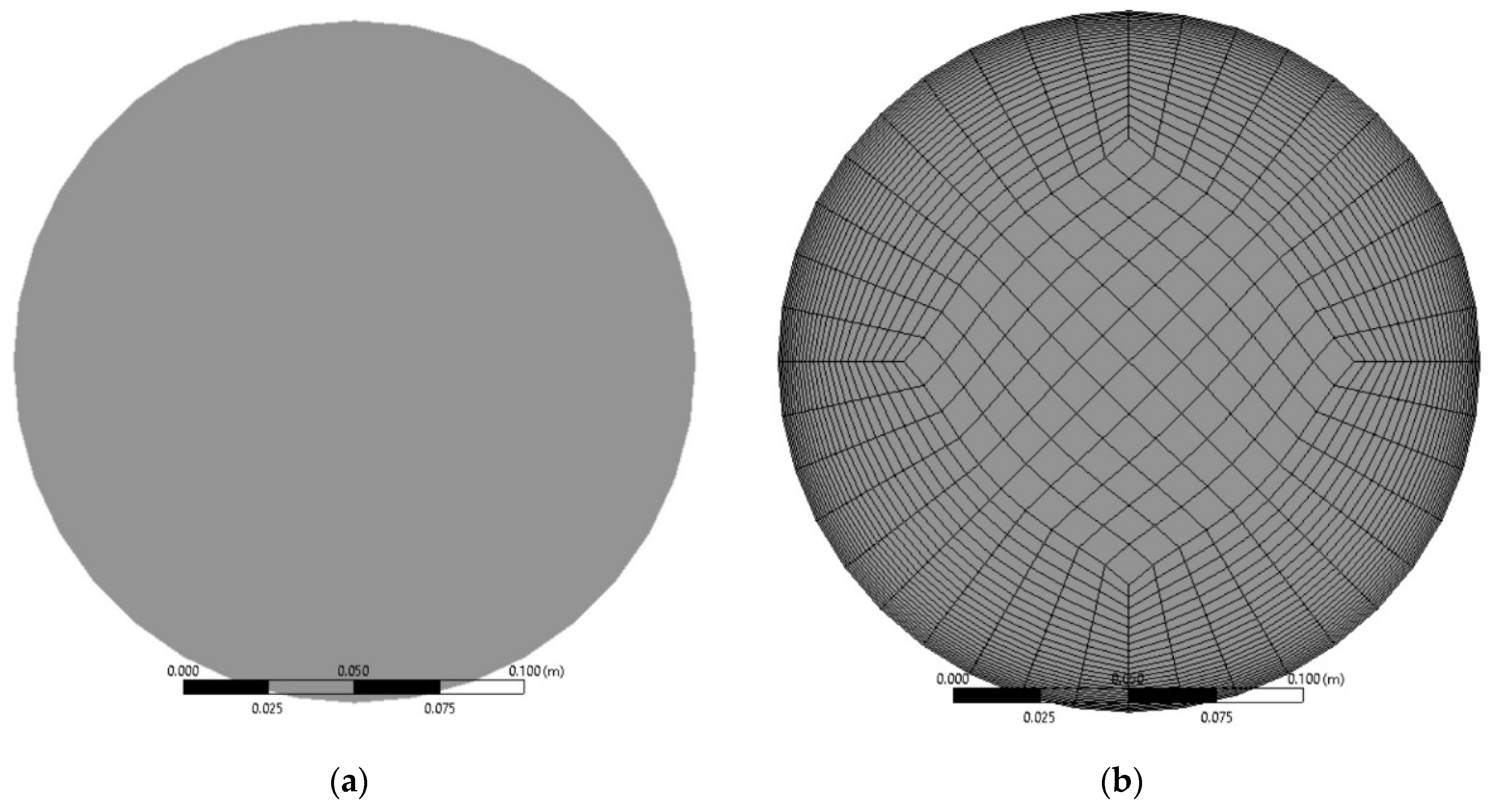
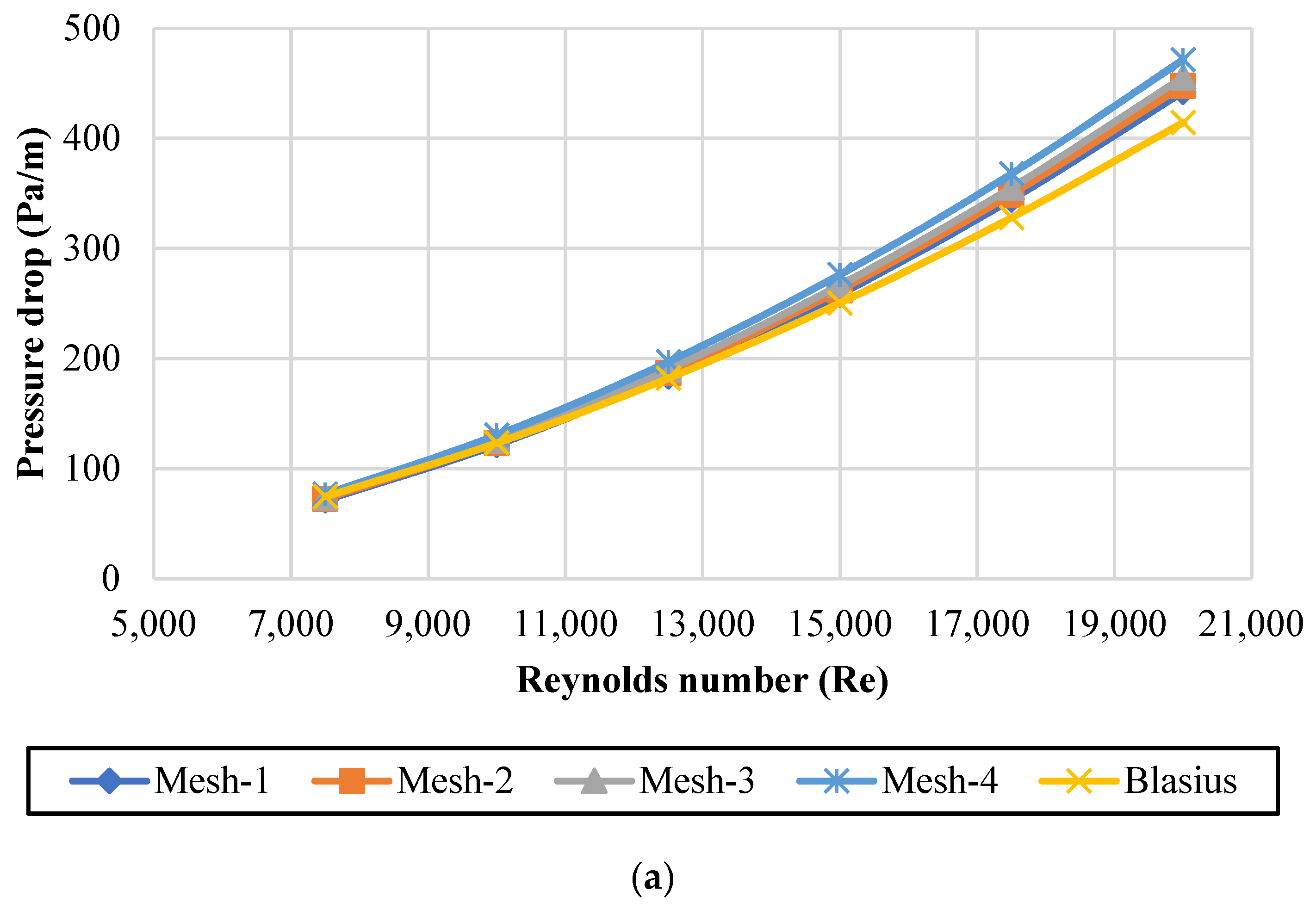
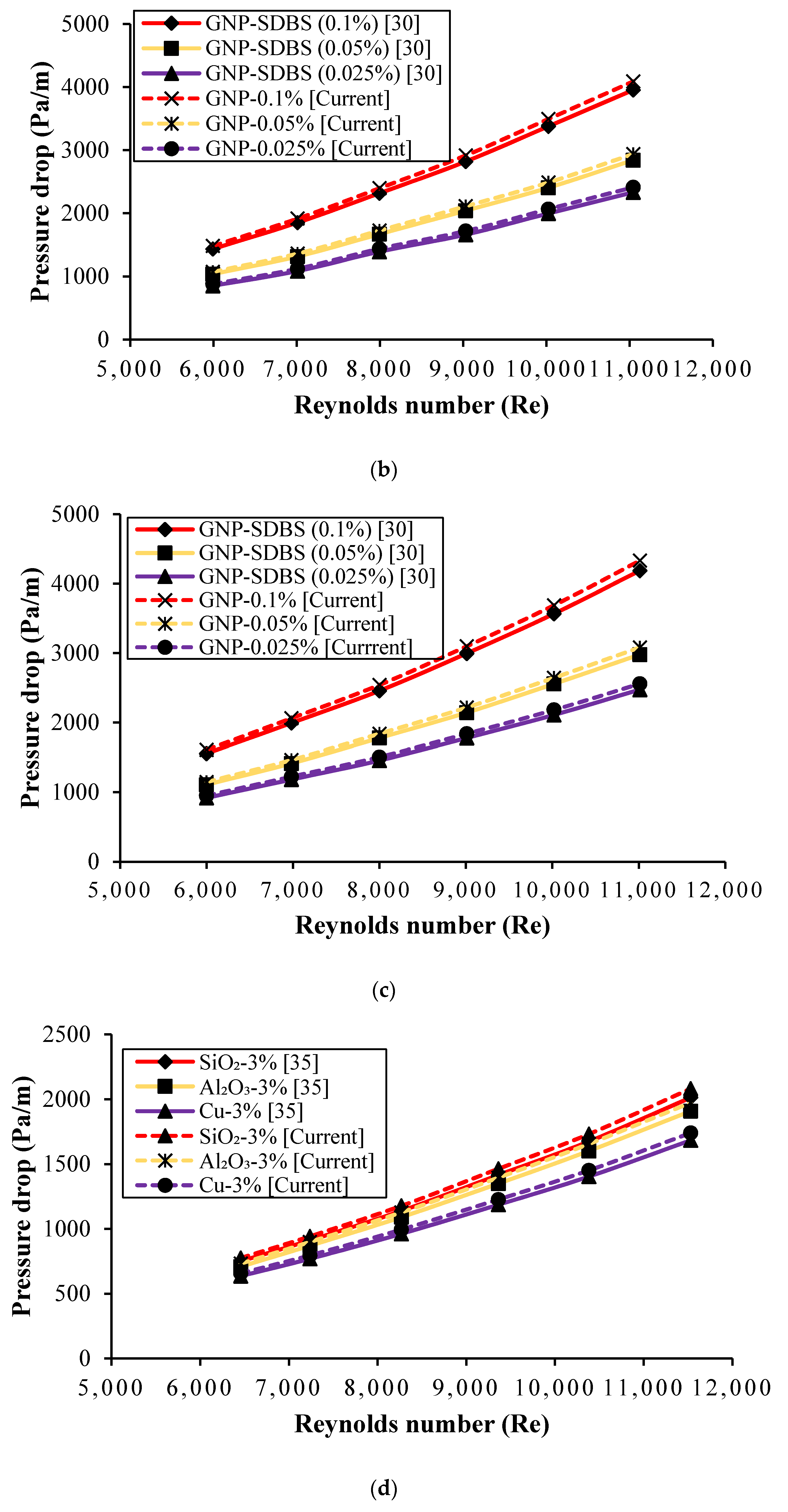

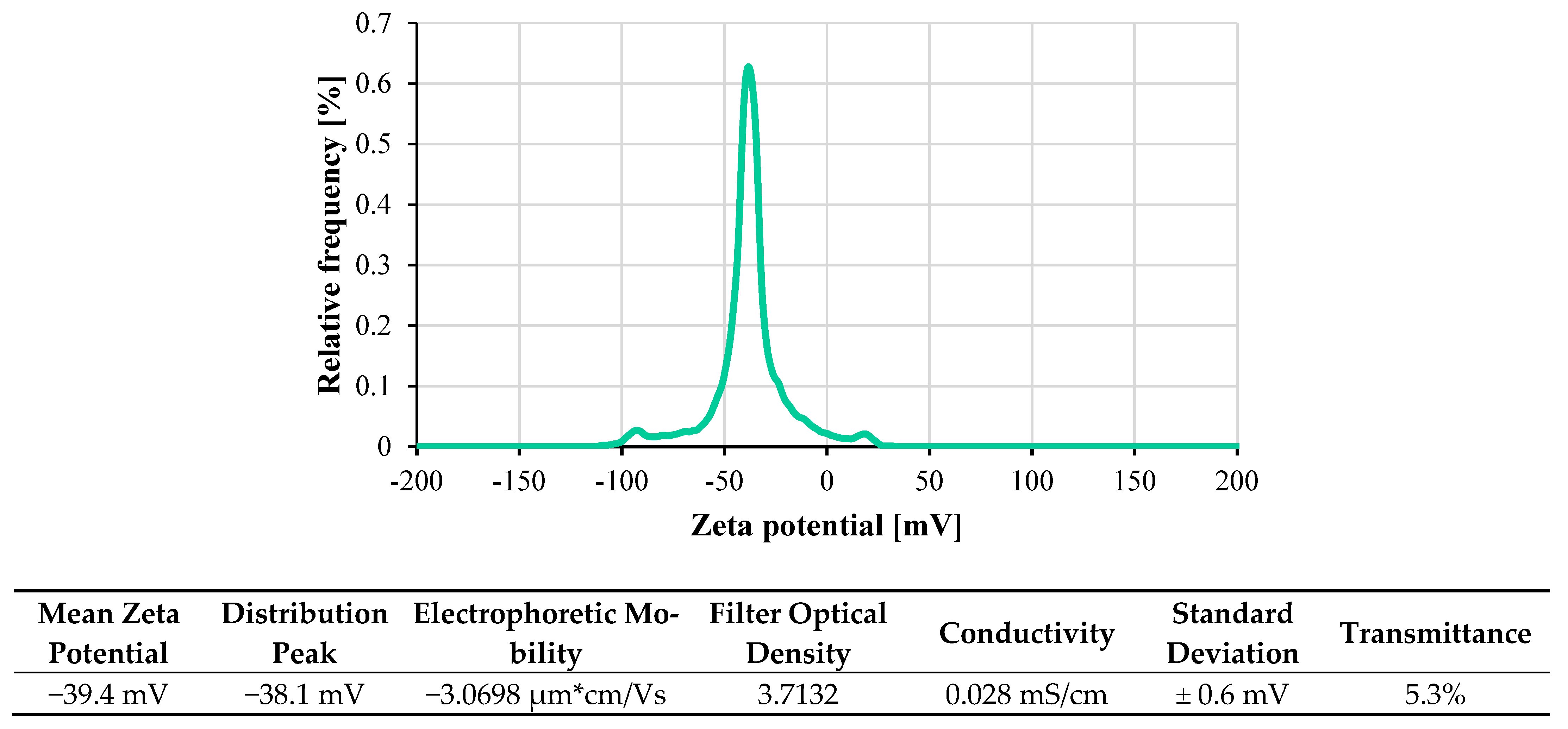
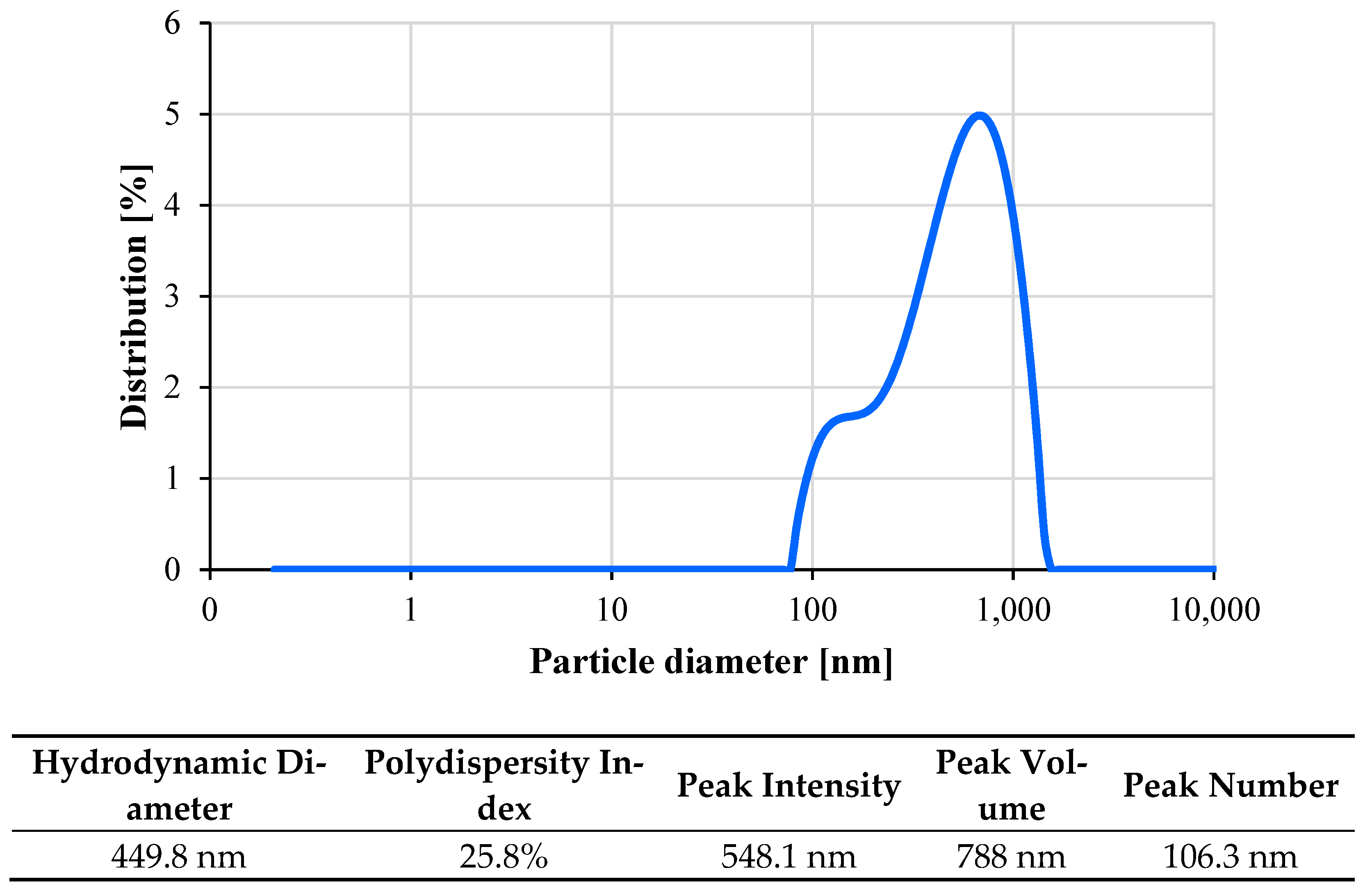


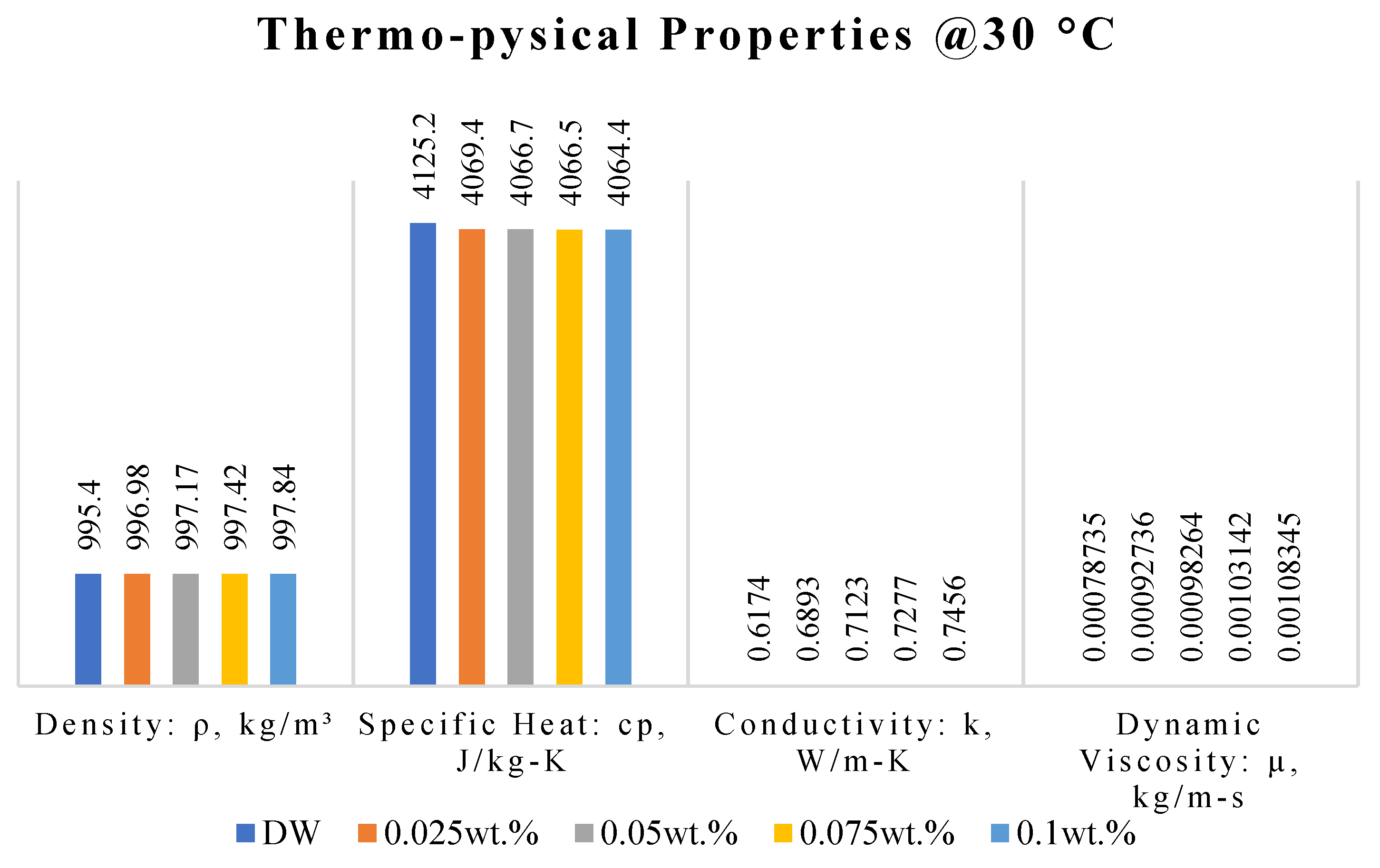

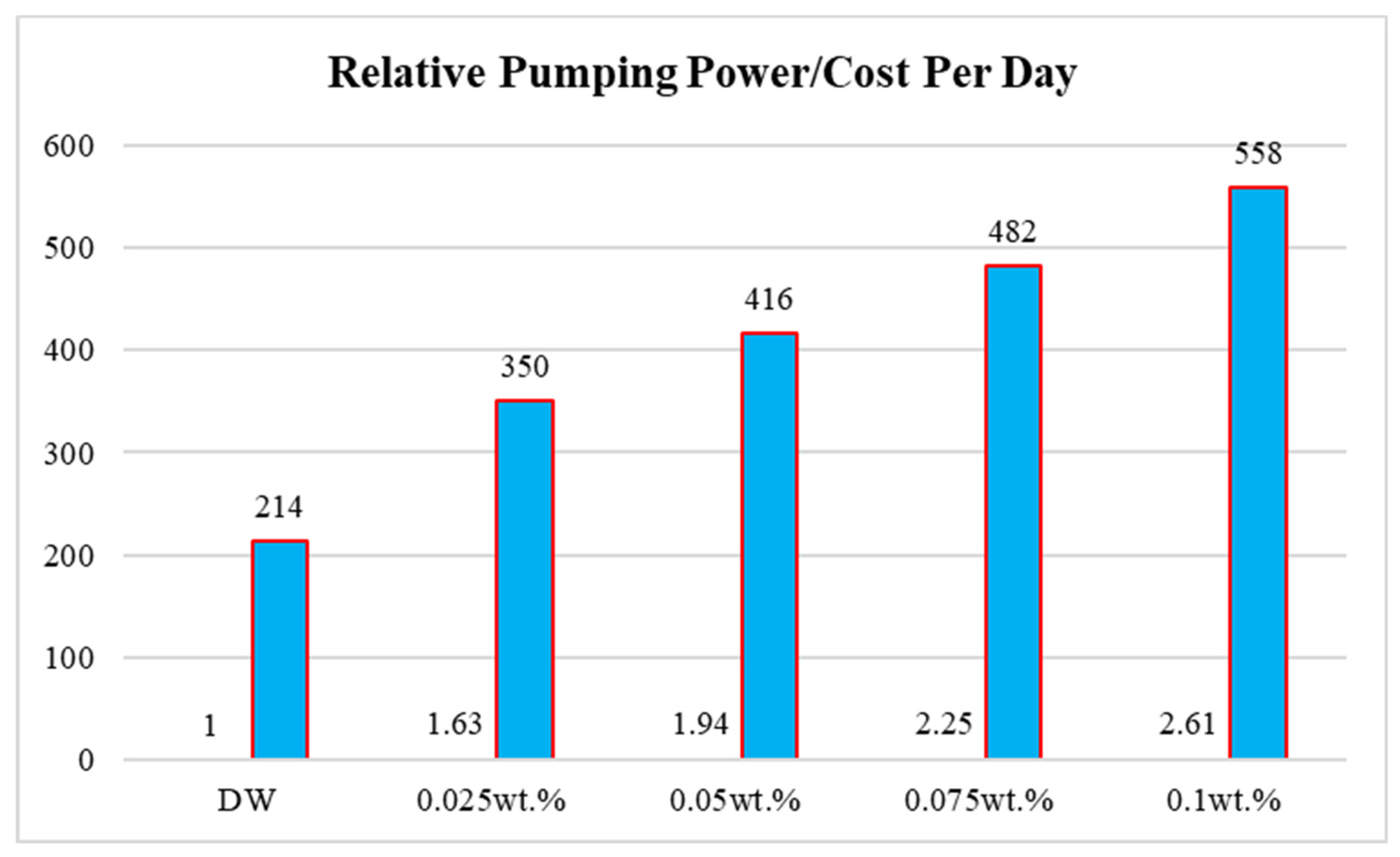
| CFD Simulation | Δy | Y+ |
|---|---|---|
| 1 | 2.89 × 10−5 | 1.790 |
| 2 | 2.25 × 10−5 | 1.571 |
| 3 | 1.85 × 10−5 | 1.433 |
| 4 | 1.58 × 10−5 | 1.339 |
| 5 | 1.38 × 10−5 | 1.269 |
| Ref. | Study Type | Basefluid | Nanoparticles | Flow Type | Remarks | |
|---|---|---|---|---|---|---|
| Type | Concentration | |||||
| [10] | Exp. | H2O | RGO, RGO+CNT, RGO+CNF, RGO+GNPs | 0.05 wt.% | Turbulent | The results recorded a small increase in pressure loss with respect to H2O. |
| [11] | CFD | H2O | CGNPs | 0.025–0.1 wt.% | Turbulent | A slight increase in the pressure loss for CGNPs compared with those for DI water. |
| [24] | Exp., CFD | H2O | GNPs | 0.025–0.1 wt.% | Turbulent | The increase in the pressure drop was in the range 0.4%-14.6%. |
| [25] | Exp. | H2O | PGGNP | 0.025–0.1 wt.% | Turbulent | The highest increment in friction factor was calculated from 4% to 14% at velocities from 1 to 3 m/s using 0.1wt.%. |
| [26] | Exp. | H2O | f-GNP | 0.02–0.1 wt.% | Turbulent | Friction factor increased by 9.22% using 0.1wt.% at Re of 17,500. |
| [27] | Exp. | H2O | CGNPs | 0.025, 0.075, 0.1 wt.% | Turbulent | The friction factor increased by about 3.79% using 0.1 wt.%. |
| [28] | Exp., CFD | H2O | GNPs, KRG, Al2O3, SiO2 | 0.025–0.01wt.% | Turbulent | The pressure drop increased about 23%, 24%, 29%, and 123% for Al2O3–DW, SiO2–DW, KRG, and GNP–SDBS, respectively. |
| [40] | Exp. | Pure oil | GNPs, MWCNTs | 0.05wt.%, 0.1wt.%, 0.2wt%, 0.5wt.% | Laminar | The highest-pressure drop was observed in the presence of OA-MWCNTs in pure oil at a concentration of 0.5 wt.% and 50 mL/s, which was 6.3%. |
| [41] | Exp., CFD | H2O | GNPs, TiO2 | 0.5, 0.75, and 1wt.% | Laminar-Turbulent | The maximum pressure drop was 1.2 times relative to DW at the highest Re for 1wt.% GNPs. |
| Current study | CFD | H2O | CF-GNPs | 0.025–0.1 wt.% | Turbulent | Pressure drop increased by 27.80%, 35.69%, 41.61% and 47.04%, respectively. |
Publisher’s Note: MDPI stays neutral with regard to jurisdictional claims in published maps and institutional affiliations. |
© 2021 by the authors. Licensee MDPI, Basel, Switzerland. This article is an open access article distributed under the terms and conditions of the Creative Commons Attribution (CC BY) license (https://creativecommons.org/licenses/by/4.0/).
Share and Cite
Mohammad, R.S.; Aldlemy, M.S.; Hassan, M.S.A.; Abdulla, A.I.; Scholz, M.; Yaseen, Z.M. Frictional Pressure Drop and Cost Savings for Graphene Nanoplatelets Nanofluids in Turbulent Flow Environments. Nanomaterials 2021, 11, 3094. https://doi.org/10.3390/nano11113094
Mohammad RS, Aldlemy MS, Hassan MSA, Abdulla AI, Scholz M, Yaseen ZM. Frictional Pressure Drop and Cost Savings for Graphene Nanoplatelets Nanofluids in Turbulent Flow Environments. Nanomaterials. 2021; 11(11):3094. https://doi.org/10.3390/nano11113094
Chicago/Turabian StyleMohammad, Reem Sabah, Mohammed Suleman Aldlemy, Mu’ataz S. Al Hassan, Aziz Ibrahim Abdulla, Miklas Scholz, and Zaher Mundher Yaseen. 2021. "Frictional Pressure Drop and Cost Savings for Graphene Nanoplatelets Nanofluids in Turbulent Flow Environments" Nanomaterials 11, no. 11: 3094. https://doi.org/10.3390/nano11113094
APA StyleMohammad, R. S., Aldlemy, M. S., Hassan, M. S. A., Abdulla, A. I., Scholz, M., & Yaseen, Z. M. (2021). Frictional Pressure Drop and Cost Savings for Graphene Nanoplatelets Nanofluids in Turbulent Flow Environments. Nanomaterials, 11(11), 3094. https://doi.org/10.3390/nano11113094









